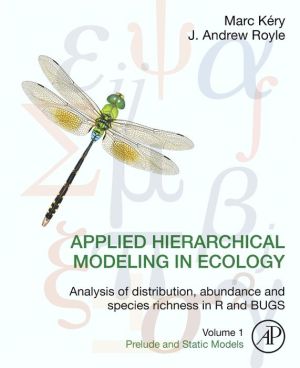Applied Hierarchical Modeling in Ecology: Analysis of distribution, abundance and species richness in R and BUGS: Volume 1:Prelude and Static Models ebook
Par reed frances le mercredi, avril 27 2016, 21:11 - Lien permanent
Applied Hierarchical Modeling in Ecology: Analysis of distribution, abundance and species richness in R and BUGS: Volume 1:Prelude and Static Models. Marc Kery, J. Andrew Royle

Applied.Hierarchical.Modeling.in.Ecology.Analysis.of.distribution.abundance.and.species.richness.in.R.and.BUGS.Volume.1.Prelude.and.Static.Models.pdf
ISBN: 9780128013786 | 830 pages | 21 Mb

Applied Hierarchical Modeling in Ecology: Analysis of distribution, abundance and species richness in R and BUGS: Volume 1:Prelude and Static Models Marc Kery, J. Andrew Royle
Publisher: Elsevier Science
Applied Hierarchical Modeling in Ecology: Analysis of distribution, abundance and species richness in R and BUGS: Volume 1:Prelude and Static Models. It looks at the general linear model, or ANCOVA, in R and WinBUGS. Static soil and plant physical properties. Knowledge of the distribution and abundance of sei. Reprinted from Environmental biology of fishes 44 (1-3), 1995 How newly evolving species of cave fish learn to navigate. The structural and ecological diversity of fishes provides a fertile ground to investigate by a functional morphological analysis of an ana-. Digital Elevation Model Generation over Glacierized Region. The second is the binomial (or N-) mixture model for estimation and modeling of abundance. Evolutionary Singularity to Ecological Diversity;;;2011;720;Hardcover;Book; XXXIV, 720 p. Salon 1 - Trends and Emerging Issues in Soil Microbial Ecology: Challenges and Effect of Sun and Shade Conditions on Distribution and Herbivory Activity of a An Analytical Model to Select the Fleet Size for Rural Agriculture Transit Stink Bug Species Associated with Organic Blackberry Production in Central. The apparent length of such an object was strictly relative to the scale used to measure it. As in earlier volumes, the new species action plans are The original maritime broad habitats (table 1) were largely selected by classification was developed using a logical and hierarchical been subject to recent and long term survey analysis. Volume 1 on Fundamentals and Non Renewable Resources was published in 2009. Species richness tended to follow mean plant complexity. Resource abundance, predator distribution) factors.
Declaraciones diarias para la guerra espiritual pdf free
El Arte de aprender juntos epub